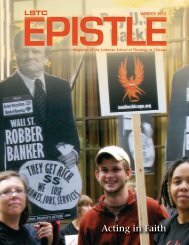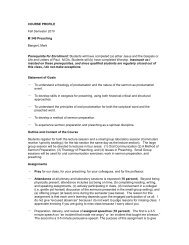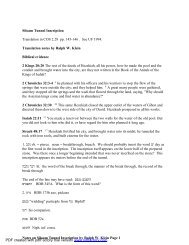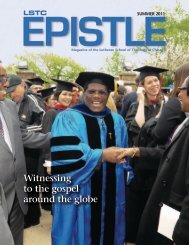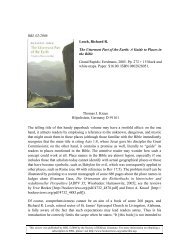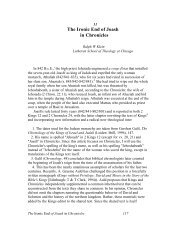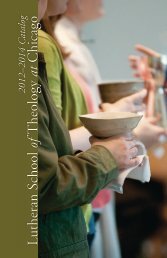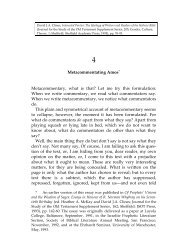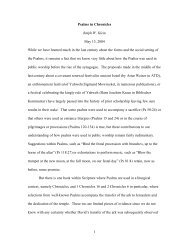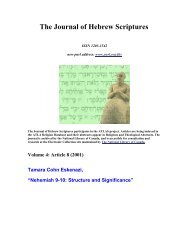Download this PDF file - University of Alberta - Journal Hosting
Download this PDF file - University of Alberta - Journal Hosting
Download this PDF file - University of Alberta - Journal Hosting
Create successful ePaper yourself
Turn your PDF publications into a flip-book with our unique Google optimized e-Paper software.
“IN CONVERSATION WITH ODED LIPSCHITS” 21the area <strong>of</strong> Benjamin plays a crucial role in Lipschits’ study. Benjamin’srelative prominence during the Neo-Babylonian era diminishedsomewhat during the course <strong>of</strong> the Persian period as other areas andsites, such as Jerusalem, began to recover from the Babylonianonslaughts, but Benjamin retained significant importance in the largercontext <strong>of</strong> the province <strong>of</strong> Judah. In sum, Lipschits argues that both theextent <strong>of</strong> the Babylonian deportations and the extent <strong>of</strong> the returnsduring the Achaemenid era have been greatly exaggerated in much <strong>of</strong>biblical scholarship.2. SPECIFIC COMMENTSIn what follows, I would like to <strong>of</strong>fer a series <strong>of</strong> questions andreflections on select aspects <strong>of</strong> Lipschits’s work. Some <strong>of</strong> thesecomments will reinforce points made by the author, while others willseek further clarification or qualification. Recognizing that othersreviewing <strong>this</strong> book will focus on archeology and the relevance <strong>of</strong>certain literary texts, such as Ezra-Nehemiah, I will focus most, albeitnot all, <strong>of</strong> my attention on Kings, Jeremiah, and Chronicles.First, with respect to the archaeology <strong>of</strong> the region during the lateIron Age and early Persian period, Lipschits draws upon the results <strong>of</strong>both site surveys, which try to capture long-term demographic trends,and rural archaeology, which studies life in small towns, villages, andfarmsteads. Both <strong>of</strong> these approaches promise to inform us aboutdemographic trends and have the potential to correct some <strong>of</strong> thebroader historical claims made by those focusing solely on the results <strong>of</strong>tell-centered archaeology.In <strong>this</strong> context, I think that it would be helpful if Lipschits wouldengage the results <strong>of</strong> Avi Faust’s research in a more sustained way. 10Faust’s work in rural archaeology draws a contrast between the situationin rural Judah and that in rural Samaria, discussing a large number <strong>of</strong>farmsteads—as well as some hamlets and villages—that have beenexcavated in the Samaria highlands. Almost all <strong>of</strong> these Iron Age ruralsites exhibit continuity into the Persian period. By contrast, there is adramatic drop-<strong>of</strong>f in Judah. This is an important comparison, becausesome have claimed that the Neo-Babylonian campaigns only involvedthe larger urban sites and not many <strong>of</strong> the smaller villages and10 Among the relevant studies are Faust’s “The Rural Community inAncient Israel during Iron Age II,” BASOR 317 (2000) 17-39; idem,“Jerusalem’s Countryside during the Iron Age II—Persian Period Transition,”in New Studies on Jerusalem: Proceedings <strong>of</strong> the Seventh Conference, ed. A. Faust and E.Baruch (Ramat-Gan: Ingeborg Rennert Center for Jewish Studies, Bar Ilan<strong>University</strong>, 2001) 83-89 (Hebrew); idem, “Judah in the Sixth Century B.C.E.: ARural Perspective,” PEQ 135 (2003) 37-53; idem, “The Farmstead in theHighlands <strong>of</strong> Iron Age II Israel,” in The Rural Landscape <strong>of</strong> Ancient Israel, ed. A.M. Maeir, S. Dar, Z. Safrai (BAR International Series 1121; Oxford:Archaeopress, 2003) 91-103; idem, “Farmsteads in the Foothills <strong>of</strong> WesternSamaria: A Reexamination;” in “I will speak the riddles <strong>of</strong> ancient times”:Archaeological and Historical Studies in Honor <strong>of</strong> Amihai Mazar on the Occasion <strong>of</strong> hisSixtieth Birthday, eds. A.M Maeir and P. De Miroschedji (Winona Lake, Ind. :Eisenbrauns, 2006). All <strong>of</strong> these works deal with the insights afforded by ruralarchaeology.



